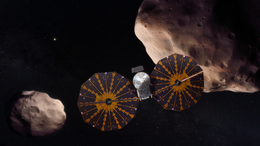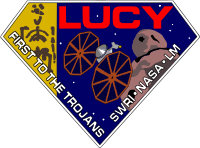
Back لوسي (مسبار فضائي) Arabic Lucy (svemirska letjelica) BS Lucy (nau espacial) Catalan Lucy (sonda) Czech Lucy (Raumsonde) German Lucy (sonda espacial) Spanish Lucy (kosmoseaparaat) Estonian Lucy (espazio zunda) Basque لوسی (فضاپیما) Persian Lucy (sonde spatiale) French
 Artist's conception of Lucy spacecraft flying past the Trojan asteroid 617 Patroclus and its binary companion Menoetius | |
| Names | Discovery Mission 13 |
|---|---|
| Mission type | Multiple-flyby of asteroids |
| Operator | NASA Goddard · SwRI |
| COSPAR ID | 2021-093A |
| SATCAT no. | 49328 |
| Website | lucy |
| Mission duration | 12 years (planned) 2 years, 7 months and 14 days (in progress) |
| Spacecraft properties | |
| Manufacturer | Lockheed Martin |
| Launch mass | 1,550 kg (3,420 lb)[1] |
| Dry mass | 821 kg (1,810 lb) |
| Dimensions | 13 m (43 ft) in long [2] Each solar panel: 7.3 m (24 ft) in diameter |
| Power | 504 watts (furthest encounter) |
| Start of mission | |
| Launch date | 16 October 2021, 09:34 UTC[1][3] |
| Rocket | Atlas V 401 (AV-096) |
| Launch site | Cape Canaveral SLC-41 |
| Contractor | United Launch Alliance |
| Instruments | |
| High-resolution visible imager (L'LORRI) Optical and near-infrared imaging spectrometer (L'Ralph) Thermal infrared spectrometer (L'TES) | |
 Lucy mission patch | |
Lucy is a NASA space probe on a twelve-year journey to eight different asteroids. It is slated to visit two main belt asteroids as well as six Jupiter trojans – asteroids that share Jupiter's orbit around the Sun, orbiting either ahead of or behind the planet.[4][5] All target encounters will be flyby encounters.[6] The Lucy spacecraft is the centerpiece of a US$981 million mission.[7] It was launched on 16 October 2021.
On 4 January 2017, Lucy was chosen, along with the Psyche mission, as NASA's Discovery Program missions 13 and 14 respectively.[6][8]
The mission is named after the Lucy hominin fossils, because study of the trojans could reveal the "fossils of planet formation": materials that clumped together in the early history of the Solar System to form planets and other bodies.[9] The hominid was named after the 1967 Beatles song "Lucy in the Sky with Diamonds".[10] The spacecraft carries a disc made of lab-grown diamonds for its L'TES instrument.[11]
- ^ a b "Lucy". NASA Space Science Data Coordinated Archive. Archived from the original on 16 October 2021. Retrieved 3 February 2023.
- ^ "The Lucy Spacecraft and Payload". Southwest Research Institute. 9 July 2018. Archived from the original on 16 November 2021. Retrieved 7 December 2018.
- ^ "U.S. Launch Schedule". NASASpaceflight.com. 16 October 2021. p. 206. Archived from the original on 1 November 2021. Retrieved 21 October 2021.
- ^ Hille, Karl (21 October 2019). "NASA's Lucy Mission Clears Critical Milestone". NASA. Archived from the original on 22 October 2019. Retrieved 5 December 2020.
 This article incorporates text from this source, which is in the public domain.
This article incorporates text from this source, which is in the public domain.
- ^ "Lucy: The First Mission to the Trojan Asteroids". NASA. 21 April 2017. Archived from the original on 6 December 2020. Retrieved 16 October 2021.
 This article incorporates text from this source, which is in the public domain.
This article incorporates text from this source, which is in the public domain.
- ^ a b Chang, Kenneth (6 January 2017). "A Metal Ball the Size of Massachusetts That NASA Wants to Explore". The New York Times. Archived from the original on 7 January 2017. Retrieved 2 March 2017.
- ^ "Watch a video tour of NASA's Lucy asteroid explorer". Spaceflight Now. 6 October 2021. Archived from the original on 6 October 2021. Retrieved 7 October 2021.
- ^ Northon, Karen (4 January 2017). "NASA Selects Two Missions to Explore the Early Solar System". NASA. Archived from the original on 5 January 2017. Retrieved 5 January 2017.
 This article incorporates text from this source, which is in the public domain.
This article incorporates text from this source, which is in the public domain.
- ^ Witze, Alexandra (16 March 2015). "Five Solar System sights NASA should visit". Nature. Archived from the original on 25 November 2020. Retrieved 2 October 2015.
- ^ Johanson, Donald C.; Wong, Kate (2010). Lucy's Legacy: The Quest for Human Origins. Crown Publishing Group. pp. 8–9. ISBN 978-0-307-39640-2.
- ^ "NASA's asteroid hunter Lucy soars into the sky with diamonds". Los Angeles Times. 16 October 2021. Archived from the original on 16 October 2021. Retrieved 16 October 2021.
© MMXXIII Rich X Search. We shall prevail. All rights reserved. Rich X Search